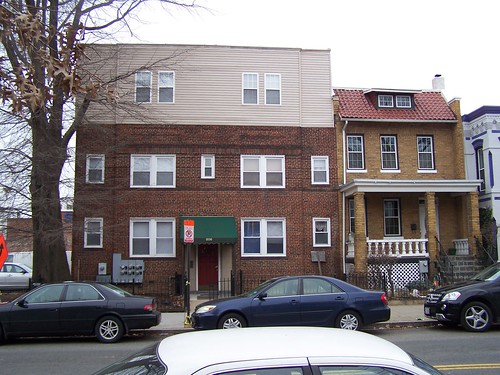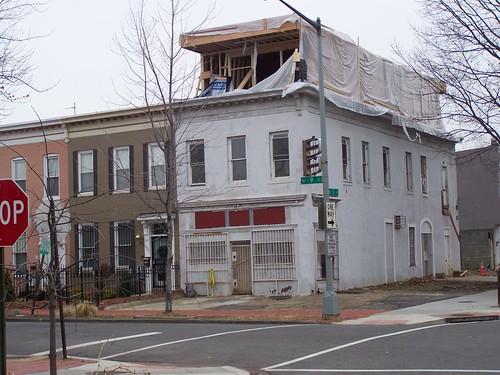What you don't know can make for flawed analysis
Heritage wanted more space on top for a meeting room and executive offices, and had their architect work with the city’s Historic Preservation Office to draw up plans that would pass muster with the review board. Along the way, the Advisory Neighborhood Commission, Capitol Hill business groups—even the federal Commission on Fine Arts—all signed off the plans.
Still, the Historic Preservation Office staff wanted the addition to be set back 25 feet to minimize its visibility. In September 2008, with CHRS pushing for no addition at all, the review board approved the staff’s recommendation as a “compromise.” From Heritage’s perspective, that would have made the renovations—which they had already started, after obtaining separate approval for the bottom floors—not even worth the cost.
Heritage immediately appealed to the next level: the mayor, who has the authority to approve building permits in historic districts. For years, an administrative law judge had served as the Mayor’s Agent, before Adrian Fenty installed his Office of Planning director, Harriet Tregoning, in the role.
In a December 2008 hearing, arguments came down to a fundamental question: Does the Historic Preservation Act allow alterations that contribute to the overall architectural quality of the building? Or must the original intent of the builder, and the historic character of the block, be privileged above all else?
Then-HPRB chairman Tersh Boasberg set the stakes high: “Because of precedent, if we were to add a third story or a fourth story to all of the buildings who came before us in this similar circumstances, then the character of Capitol Hill would be terribly changed.” ...
In her decision nine months later, Tregoning agreed, finding that Heritage shouldn’t be punished because of the potential impact on later applications. The overall design was of high quality, and a roofline may not deserve protection.
But the most dangerous element of her analysis, from CHRS and Boasberg’s perspective, was the argument that the Mayor’s Agent owes no special deference to the HPRB.
Being a preservationist myself, I am often a serious critic of the way we handle various preservation matters in the city, not to mention that we are inadequately explaining why preservation matters generally, how it has been essential to the stabilization and improvement of once declining and shrinking neighborhoods setting the stage for today's successful city, and that we could do a better job of reaching out to and including new audiences in our organizations and activities.
1. Typically, higher courts/appeal processes build upon and pay deference to the particular laws, regulations, oversight-decision-making bodies upholding the matter at issue.
Recognizing of course that the appeal process allows for and does make decisions on broader criteria than that employed by Historic Preservation Review Board and the Historic Preservation Office which are bound only by the historic preservation act as amended, federal historic preservation laws relevant to the board's purview, and the regulations carrying out these laws.
2. The Mayor's Agent, depending on who the appointment is (in this case, the Director of the Office of Planning), may not in fact be impartial and objective if their position in government is without civil service protections, but instead held at the pleasure of elected officials (in this case the Mayor) and the appointed officials who carry out Executive decisions (in this case the Deputy Mayor of Planning and Economic Development).
And note also that I have a great deal of respect for Harriet Tregoning, the director of the Office of Planning, I love talking planning theory with her, and I asked her for and received a reference and advice in the process of my applying for a temporary (grant funded, one year maximum term) position at the Baltimore County Office of Planning. (She used to be Secretary of Planning for the State of Maryland, and her word carries a lot of weight in planning circles in Maryland.)
The point in this matter regarding the impartiality of decision making on the part the Mayor's Agent is particularly important, recognizing that positions serving at the pleasure of the Executive are not fully independent and therefore subject to suasion and/or directives that may not necessarily conform with the law. (For another similar instance of undue executive influence over preservation matters, see this article "Apple Store Design Hits a Glass Wall Again" from the Washington Post concerning the design of the Apple Store in Georgetown.)
At the end of the day, the director of the Office of Planning has to take orders from the Mayor or his/her designates. That's the nature of government. And you don't really understand that until you work in it, even if for a brief period.
3. The issue of roof line and building height and additions to buildings in historic districts is a key matter that is deserving of broader debate, discussion, and consideration, rather than through an ad hoc building-by-building consideration through cases before the Mayor's Agent, especially in terms of points one and two.
Labels: building regulation, electoral politics and influence, historic preservation, law and the legal process, zoning





1 Comments:
A debt of gratitude is in order for your glorious posting! I very delighted in understanding it.
Post a Comment
<< Home